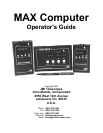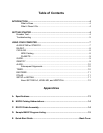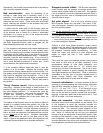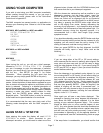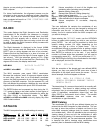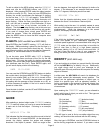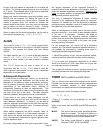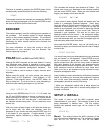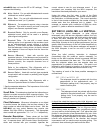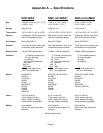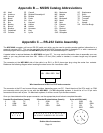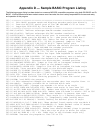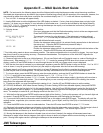Page 7
USING YOUR COMPUTER
If you wish to start using your MAX computer immediately
without reading through the manual, or you just want a
quick refresher course, please refer to the Quick-Start
Guide found in Appendix E.
The MAX computer has several modes, or applications to
enhance your observing time. Below is a list of the modes
available:
NGC-MAX, NGC-miniMAX and NGC-microMAX
ALIGN STAR or STAR FIX
RA DEC
CATALOG
GUIDE
ALIGN
ENCODER
SETUP or Install
NGC-MAX and NGC-miniMAX
TIMER
POLAR
NGC-MAX
IDENTIFY
Upon turning the unit on, you will see a brief message,
followed by
ALIGN STAR or STAR FIX. (If instead
you see a message to point the telescope a particular
direction, you should do so if you plan to align the computer
with the sky. See SETUP on page 11 for further
information. When operating the unit apart from the
telescope, you may simply press ENTER at this point.)
Use the UP and DOWN buttons to scroll through the various
modes. Notice that either of these buttons pressed for more
than an instant will cause the options to scroll faster until the
button is released. Following is a detailed description of
each of these modes and how to use them. For reference,
the UP and DOWN buttons scroll through options (whether
choosing a mode, star name, catalog number or other
option), and the ENTER button selects the currently
displayed option. The MODE button is solely for returning
to the mode level to permit selection of a new mode.
It is recommended that the new user study each of the
following mode descriptions with the MAX computer in
hand.
ALIGN STAR or STAR FIX
Upon entering this mode, the display will read
ALIGN
ACHERNAR or similar. When connected to your
telescope's encoders, you would need to select one of the
alignment stars (chosen with the UP/DOWN buttons) and
then center that star in your telescope's eyepiece.
With the chosen star centered as well as possible in your
telescope's eyepiece (not the finder scope), press the
ENTER button to align the MAX computer on that star.
Never use Polaris as an alignment star for an Equatorial
mount and never use a star near Zenith for an Alt/Az mount.
Any delay in pressing the ENTER button might allow the
star to drift slightly from center, thereby decreasing the
accuracy of your alignment — try to keep this delay as small
as possible, with five seconds or less being about right. For
increased accuracy during the alignment process, it is
recommended that a short focal length (high power)
eyepiece be used.
If you should accidentally press the ENTER button and align
the MAX computer before you had the star centered in your
eyepiece, you will need to reset the unit by turning it off,
waiting five seconds, and then turning it back on.
When you press ENTER for the first alignment, the MAX
computer will briefly report a "warp" factor such as the
following:
WARP=- 0.2
If you are using either of the EP or GP mount settings,
which assume that the mount is perfectly polar aligned, the
warp value will show zero and you will be ready to begin
using the other features of the unit. If you are not using EP
or GP (see SETUP on page 11) then you should finish this
section before continuing.
Since the telescope is not perfectly polar aligned (i.e. you
are not using the EP or GP mode), you will need to align on
one more star to complete the alignment procedure. For
best results, the second star should be between 60° and
120° distance from the first star. Simply repeat the initial
procedure of selecting a star name, pointing the scope to
that star, then pressing ENTER. (Note: for simplicity, the
method of aligning on two stars is presented here. In
reality, the user may choose to align on any two objects in
the MAX computer database, including the user definable
objects, via the
ALIGN mode.)
Once again you will see a warp factor displayed. This
message is reporting how many degrees the telescope is
from where the MAX computer expected it to be when
pointing at your selected alignment object. This number
should be within plus or minus one-half degree of zero
(±0.5). Any value greater than this should be considered an
error indication. (It is possible to have a perfect warp factor
and still have very poor pointing accuracy if one or both of
the encoders is appearing to run the opposite direction. If
this is experienced, see the Troubleshooting Guide on page
5.)
If the warp factor is considerable, you should confirm that



